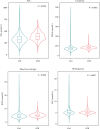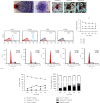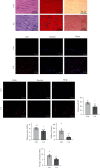Asymptomatic Hyperuricemia Is Associated with Achilles Tendon Rupture through Disrupting the Normal Functions of Tendon Stem/Progenitor Cells
- PMID: 36504525
- PMCID: PMC9731760
- DOI: 10.1155/2022/6795573
Asymptomatic Hyperuricemia Is Associated with Achilles Tendon Rupture through Disrupting the Normal Functions of Tendon Stem/Progenitor Cells
Abstract
Hyperuricemia is a metabolic disorder that is essential to the development of inflammatory gout, with increasing prevalence over recent years. Emerging clinical findings has evidenced remarkable tendon damage in individuals with longstanding asymptomatic hyperuricemia, yet the impact of hyperuricemia on tendon homeostasis and associated repercussions is largely unknown. Here, we investigated whether asymptomatic hyperuricemia was associated with spontaneous ruptures in the Achilles tendon and the pathological effect of hyperuricemia on the tendon stem/progenitor cells (TSPCs). Significantly higher serum uric acid (SUA) levels were found in 648 closed Achilles tendon rupture (ATR) patients comparing to those in 12559 healthy volunteers. In vitro study demonstrated that uric acid (UA) dose dependently reduced rat Achilles TSPC viability, decreased the expressions of tendon collagens, and deformed their structural organization while significantly increased the transcript levels of matrix degradative enzymes and proinflammatory factors. Consistently, marked disruptions in Achilles tendon tissue structural and functional integrity were found in a rat model of hyperuricemia, together with enhanced immune cell infiltration. Transcriptome analysis revealed a significant elevation in genes involved in metabolic stress and tissue degeneration in TSPCs challenged by hyperuricemia. Specifically, reduced activity of the AKT-mTOR pathway with enhanced autophagic signaling was confirmed. Our findings indicate that asymptomatic hyperuricemia may be a predisposition of ATR by impeding the normal functions of TSPCs. This information may provide theoretical and experimental basis for exploring the early prevention and care of ATR.
Copyright © 2022 Jingjing Liang et al.
Conflict of interest statement
The authors declare that there is no conflict of interest.
Figures





References
-
- Chen-Xu M., Yokose C., Rai S. K., Pillinger M. H., Choi H. K. Contemporary prevalence of gout and hyperuricemia in the United States and decadal trends: the National Health and Nutrition Examination Survey, 2007–2016. Arthritis & Rhematology . 2019;71(6):991–999. doi: 10.1002/art.40807. - DOI - PMC - PubMed
LinkOut - more resources
Full Text Sources
Miscellaneous

